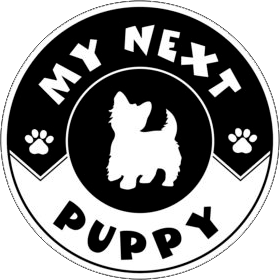-
Pomsky
About This Breed
The Pomsky a cross between a Siberian Husky and a Pomeranian is often referred to as a designer dog breed. This relatively new breed tends to be of the fluffy, cuddly variety, but there’s a lot of variation in these dogs, as well. Here’s what you need to know about this newcomer breed.
Physical Characteristics
When you cross a Pomeranian with a Siberian Husky, you can imagine some of the variations that might occur. In general, small Pomskys tend to weigh around 15 pounds when fully grown, although they could be 10 to 15 pounds larger than that estimate.
COLOR(S)
Usually some variation of white, black, and grey, similar to their Husky parent.
COAT
Soft and long
Personality and Temperament
ACTIVITY LEVEL
Moderate
POSITIVES
The Pomsky tends to be good-natured and playful, gentle with kids, and very lively. They are quick to learn and love to play and tend to be quiet pups.
THINGS TO CONSIDER
Pomsky's are very smart and require regular play to avoid becoming bored. Bored Pomskys have been known to act up by chewing. Note that the Pomsky sheds a lot, and their thick coats require extensive grooming. Pomsky's are also diggers by nature and may require training so as to not dig up your entire backyard.
Care
IDEAL LIVING CONDITIONS
The Pomsky's generally small size makes this breed the perfect companion for someone living in an apartment all the way up to a larger home.
SPECIAL REQUIREMENTS
A Pomsky requires daily exercise and stimulation to avoid boredom, as well as weekly if not daily grooming.
Health
Since the breed is so new, not much is known about any common Pomsky health conditions. Keep in mind, though, that as is common with most mixed breeds, any hereditary health conditions that show up in either the Pomeranian (such as cataracts or skin problems) or the Husky (like eye problems) may show up in your Pomsky, as well.
History and Background
As it stands, the Pomsky has a very short history, having only been bred within the past couple of years. Breeding is of particular importance when it comes to these dogs since it’s essential to take size into consideration for their birth. In general, a breeder should always use the Husky as the dam, since physical and health complications could endanger the mother and puppies if a smaller Pomeranian were to be bred to carry puppies sired by a larger male Husky.
-
Victorian Bulldog
The Victorian Bulldog is large headed and thick boned, only to the point that it does not impede vigor. It is broad muzzled and short-faced, but not so excessive as to interfere with breathing. The hindquarters are somewhat higher and not as heavy as foreparts, but not so as to destroy the symmetry of a muscular athlete. The head should be large but not exaggerated out of proportion to the body. The cheeks are rounded and extended sideways beyond the eyes.
The face is measured from the front of the cheek-bone to the tip of the nose, long enough for unhindered breathing. The muzzle is broad and turning up, undershot but not to excess. The nostrils are large and wide, black is preferred but dudley acceptable. The flews are broad and hanging over the lower jaw at the sides. The canine teeth are large and wide apart. The eyes from the front are set low and wide apart, never bulging or sunken and never with the haw be visible.
The ears are either rose or button and are never erect or cropped. The neck is thick, strong, and arched, with loose skin forming dewlap on each side. The shoulders are broad and deep. The Victorian Bulldog has rounded ribs with a wide chest narrowing towards the loins without exaggeration. The forelegs are muscular, straight and wide apart, not bandy or curved. The hind legs are strong and muscular. The hocks are slightly bent. The feet are round and compact and either straight, turning down, or screwed. The coat is smooth and short. Colors include all brindles, solid white or pied, solid red, fawn, or fallow. Black or black and tan is not acceptable.
Temperament
Victorian Bulldogs are very loyal and absolutely reliable. Although its appearance can be somewhat intimidating, it is among the gentlest of dogs. Just the same it will see off any intruder. It is described as a very affectionate and dependable animal, gentle with children, but known for its courage and its excellent guarding abilities. Victorian Bulldogs are very much a people’s dog seeking out human attention and loving every bit it can get!! Human attention is required for the breed's happiness. They are nice to all people. This breed is good with family pets, but they can be scrappy with strange dogs without enough leadership from the owner. Some snore very loudly, and some have drool and slobber tendencies. Be sure to always be your dog’s Pack Leader.
Height, Weight
- Height: Dogs: 17-19 inches (43-48 cm.), Bitches: 16-19 inches (41-48 cm.)
- Weight: Dogs 70-75 pounds (32-34 kg.) Bitches 55-65 pounds (25-30 kg.)
Environment
- Apartment is fine.
- Low activity indoors.
- Thrive in moderate climates.
Exercise
- Daily moderate to extended exercise.
Grooming
- Easy care.
- Average shedding
-
Soft Coated Wheaten Terrier
As its name implies, the Soft Coated Wheaten Terrier is prized for its coat, which is soft, silky, with a gentle wave, and of warm wheaten color. Underneath, however, is a formidable dog that leaves no doubt as to his terrier origins. Square and medium-sized, he is happy, steady, self-confident, and alert to his surroundings.
History
Known for more than 200 years in Ireland, the “Wheaten” shares a common ancestry with the Kerry Blue and the Irish Terrier but was not owned by the landed gentry. They were the poor man's dog, an all-purpose farm dog, given to patrolling the borders of small farms, ridding them of vermin, herding sheep, and hunting with his master.
Temperament
Wheatens tend to be less scrappy than other terriers but they are true terriers and will be more active than many other breeds, enjoying plenty of exercise every day. They relate well to children and can adapt to city, country, and suburban life. The Wheaten is single coated and sheds minimally, but needs regular grooming to keep its coat mat free.
- Terrier Group; AKC recognized in 1973.
- Ranging in size from 17 to 19 inches tall at the shoulder and weighing between 30 and 40 pounds.
- Small game hunter; farm dog.
Environment
- Apartment is fine.
- Fairly active indoors.
- Be careful in hot weather.
Exercise
- Daily moderate exercise.
Grooming
- Daily combing.
- Periodic professional grooming recommended.
- Light shedding.
- Easy on allergy sufferers.
-
Silky Terrier
Although a toy in size, the Silky Terrier has a true terrier personality he is of sufficient substance to be able to hunt and kill domestic rodents. The general public occasionally confuses this breed with the Yorkie, but in reality, the Silky is larger and more closely related to the Australian Terrier. A friendly, joyful temperament and the lovely blue and tan coat make him an ideal companion.
History
Developed at the end of the 1800s in Australia, the Silky Terrier was created when a number of Yorkshire Terriers from England were brought into parts of Australia and bred to Australian Terrier bitches in an attempt to improve coat color in the blue and tan Australian Terrier. The resulting litters produced individuals shown as these three different breeds. The Silkys were then bred together until a recognized type was fixed.
Temperment
This portable pooch can adapt well to any living situation, but make sure you have the time to devote to them they do not like to be ignored, preferring to play fetch or go on walks with their family. Silkys are keen and energetic, so it's best to keep them occupied. The breed must also be bathed and brushed on a regular basis.
- Toy Group; AKC recognized in 1959.
- Ranging in size from 9 to 10 inches tall at the shoulder and approximately 10 pounds.
- Vermin hunter.
Environment
- Apartment is fine.
- Very active indoors.
Exercise
- Daily moderate exercise.
Grooming
- Daily combing and brushing.
- Regular professional grooming recommended.
- Little to no shedding.
-
Teddy Bear
The Teddy Bear puppy is also known as a Shichon or a Zuchon and it is a cross between Bichon Fris and Shih Tzu. the Teddy Bear is a dog “known for his endearing face, large expressive eyes, and his soft teddy-bear coat.” The Teddy Bear usually has a longer coat that does not shed very much, if at all. This longer coat may lead to more time for maintenance and grooming. As hypoallergenic dogs, Teddy Bears are generally more suitable for homes with allergy problems amongst the inhabitants, although allergic reactions may still occur.
This toy dog is said to have a “great” personality, and it is playful, lively, and well-mannered. They can be a bit stubborn, but when they are trained well, they are a good family pet. The breed has a tendency to bark, but with active training, this can be mastered. They are easily trained.
The Teddy Bear is a well-mannered dog known to be social, happy, and gentle. They become devoted to their families but need much attention and do not do well when left alone for long periods of time. They are good therapy dogs. Sometimes the Teddy Bear may be stubborn and in need of training. The Teddy Bear will remain active and playful throughout its life.
They make fairly good watchdogs! When necessary, this dog will bark to alert its family that someone is nearby. This breed is typically good with other pets, especially when socialized at an early age. This dog gets along well with children, but it may be a good idea to socialize this breed at an early age as well as to supervise playtime with children to make sure that the dog does not get hurt as a result of its small size.
An important feature of the Teddy Bears hybrid breed is its longevity. The average life expectancy of a Teddy Bear is around 1215 years. The Teddy Bear, like many hybrid breeds, is usually healthy without showing the congenital defects that purebreds can have from inbreeding. Although this breed of dog is relatively new, its popularity and fame are growing quickly. The Teddy Bear is still not thought of as an official breed of dog, only a cross-breed. This may change as the dog is becoming a popular toy dog being classified with all other toy dog purebreds. Organizations that recognize this breed include the American Canine Hybrid Club and the Designer Dogs Kennel Club.
-
Saint Bernard
The St. Bernard is a giant dog. The average weight of the breed is between 65 and 120 kg (140 and 260 lb) or more, and the approximate height at the withers is 70 to 90 cm (28 to 35 in). The coat can be either smooth or rough; the smooth coat being close and flat while the rough is dense, flat, and more profuse around the neck and legs. The color is typically a red shade with white or a mahogany brindle with white. Black shading is usually found on the face and ears. The tail is long and heavy, hanging low. Eyes are usually brown, but sometimes can be icy blue, and should have naturally tight lids, with haws only slightly visible.
Temperament
Known as a classic example of a Gentle Giant, the Saint Bernard is calm, patient, and sweet with adults, and especially children. However St. Bernards, like all very large dogs, must be well socialized with people and other dogs in order to prevent fearfulness and any possible aggression or territoriality. The biggest threat to small children is being knocked over by this breed's larger size. Overall they are a sweet, gentle, calm, loyal, and affectionate breed, and if socialized are very friendly. Because of its large adult size, it is essential that proper training and socialization begin while the St. Bernard is still a puppy, so as to avoid the difficulties that normally accompany training large dogs. An unruly St. Bernard may present problems for even a strong adult, so control needs to be asserted from the beginning of the dog's training. While generally not instinctively protective, a St. Bernard may bark at strangers, and their size makes them good deterrents against possible intruders.
-
Dogue de Bordeaux
A powerful and muscular French Mastiff breed, the Dogue de Bordeaux is a molluscoid (mastiff-type dog), “dogue” meaning Mastiff in French. A massive head and stocky body are trademarks of the breed. Americans became aware of the Dogue de Bordeaux when he appeared as drooling, messy “Hooch” in the 1989 Tom Hanks' film, Turner and Hooch. The breed's short, fine coat is fawn-colored, ranging from a dark red to a light fawn.
History
The Dogue de Bordeaux's history is a mystery different theories link him to the Bullmastiff, Bulldog, Tibetan Mastiff, and the ancient Dogues de Bordeuax of Aquitaine. In any case, the Dogue de Bordeaux has been used as a guardian, hunter, and fighter. They were trained to bait bulls, bears, and jaguars, hunt boars, herd cattle and protect the homes and businesses of their masters.
Temperament
The Dogue de Bordeaux possesses an instinct for guarding, which he does with vigilance and courage, but without aggressiveness. He is an excellent companion affectionate and attached to his family with a patient, calm temperament. Their short coat is easy to care for and they require moderate daily exercise. New owners should be prepared to deal with drool!
- Working Group; AKC recognized in 2008.
- Ranging in size from 23 to 27 inches tall at the shoulder and at least 99 pounds.
- Guardian; hunter.
Environment
- Apartment is ok.
- Low activity indoors.
Exercise
- Daily moderate exercise.
Grooming
- Easy care.
- Average shedding.
-
Golden Retriever
The Golden Retriever, with its intelligence and eager to please attitude, is one of the most popular breeds in the United States according to AKC registration statistics. The working ability that has made the Golden Retriever such a useful hunting companion also make him an ideal guide, assistance, and search and rescue dog. The golden-colored coat is the hallmark of this versatile breed and can range from light to dark gold.
History
The Golden Retriever originated in the Scottish Highlands in the late 1800s and was used predominantly for hunting. He crossed his original “Yellow Retriever” with the Tweed Water Spaniel (now extinct) found on his estate. Later integrations of Irish Setter, Bloodhound, and more Tweed Water Spaniel produced the retriever we know today.
Temperament
This active and energetic Sporting breed can adapt to many different living situations but requires daily exercise. His water-repellant double-coat sheds seasonally and needs regular brushing. With his friendly temperament and striking golden color, this breed is both beautiful to look at and a joy to own. The Golden Retriever is great with children and other pets. They have an average lifespan of 10-12 years.
- Sporting Group; AKC recognized in 1925.
- Average size: from 55 to 75 pounds.
- Devoted companions, hunting dog.
Environment
- Apartment is ok.
- Moderate activity indoors.
Exercise
- Daily moderate exercise.
- Love interaction and games.
Grooming
- Easy care.
- Regular brushing.
- Average shedding.

 Available Puppies
Available Puppies What People Are Saying
What People Are Saying